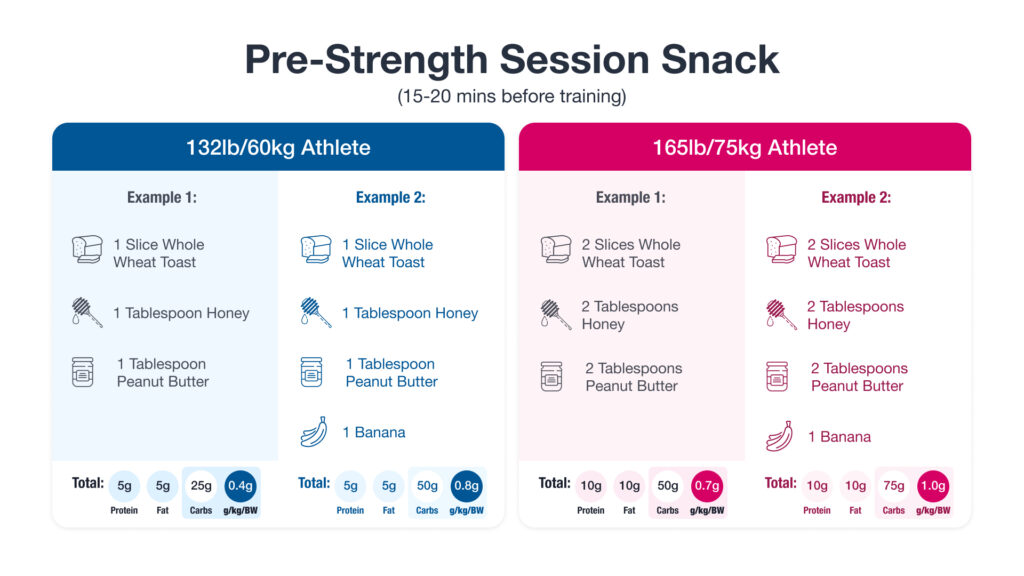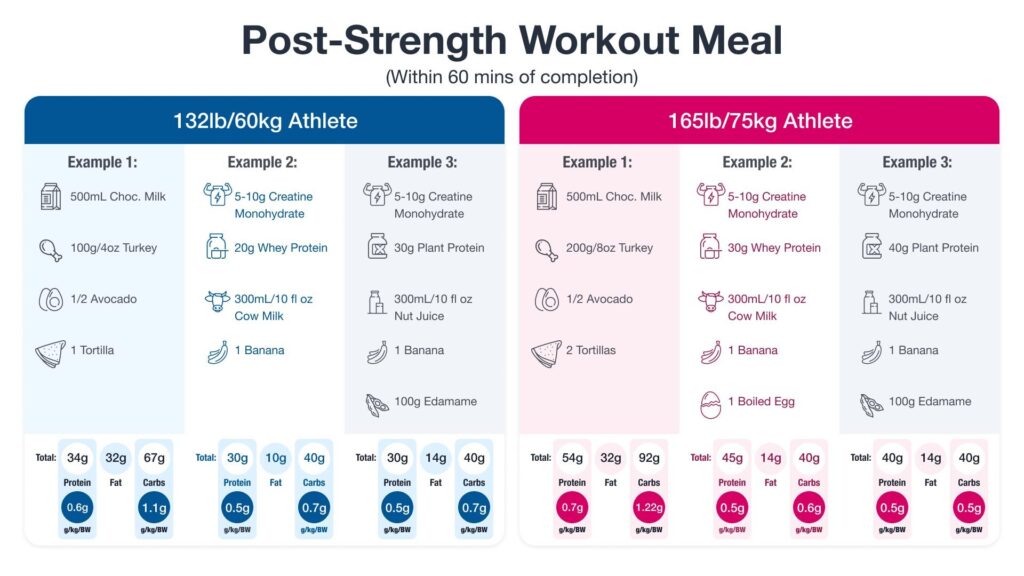Training for an endurance event is a demanding endeavor that requires a delicate balance of endurance, strength and mental resilience. Incorporating strength/gym work into your training regimen can yield significant benefits, from improved power output to injury risk reduction to overall better performance. Adding strength training on top of your already demanding training schedule introduces new challenges to your nutritional needs, though.
If you want to reap the full benefits of your hard-earned work in the gym, you need to fuel properly. This article provides scientifically supported strategies for fueling before, after, and during your strength sessions.
Balancing Macronutrient Intake
Endurance training historically relied heavily on carbohydrates to fuel long and intense sessions. Conversely, strength training has been seen to require higher protein intakes to facilitate muscle growth, retention, and repair. But this is a simplistic view of these macronutrients. Both carbs and protein are important for endurance and strength training.
Below is a description of how carbs and protein can be used to your benefit when adding strength training to your endurance program.
Strength Workouts Needs Carbs, Too
Interestingly, until 2022, there had yet to be a review of the impact of carbohydrate consumption on strength training, but this systematic review highlighted several essential takeaways. The first is that when you’re in a fed state, the performance of strength training up to ten sets per exercise is similar whether you consume carbs within the session or not. In other words, if you eat before your weights session and the number of sets is less than ten per exercise, you will not need to fuel during the training session.
Key Takeaway: When you’re in a fasted state (4-5hr fast), your strength session will likely not be as good as it would be if you were in a fed state or consuming carbs during the session.
According to the study, the positive impact of consuming carbs before a session was positively amplified when there were more than ten sets. It should be noted that the findings on the fasted vs. fed state were not unequivocal. Some performance markers and athletes were similar whether fasted or fed. This highlights the individual nature of nutrition and training.
Key Takeaway: Eat a meal beforehand to lift with purpose and perform. You may feel better lifting in a fed state rather than in a fasted state.
Getting Enough Protein is Key
Protein intake is paramount for muscle recovery and adaptation. Regardless of age, gender, or training experience, you should aim for about 2.0-2.5 grams of protein per kilogram of body weight daily. This intake should be consistent throughout the week regardless of your fluctuation in daily training hours.
Periodizing protein is not required to maximize strength gains or reap the other benefits associated with higher protein intake. These benefits include improved immune function, bone development, and satiation. Because of the satiating effect of protein, you might struggle to finish large volumes in one sitting. Eating smaller, more frequent meals containing protein sometimes makes it easier to hit your daily protein needs.
Some examples of high-quality protein sources are lean meats, dairy, eggs, and plant-based options like tofu, legumes, and quinoa. The total amount of protein consumed daily is essential to drip-feeding small amounts throughout the day.
Key Takeaway: You must consistently hit your protein number day in and day out for weeks in combination with your training to see the benefits.
Timing Matters
The timing of your meals and snacks can maximize performance gains and recovery. As mentioned above, eating meals throughout the day and timing them with training may be the practical step and requirement to hit your daily targets. The spacing of protein or “pulse feeding” is not necessarily better than larger protein feeds. However, from a practical standpoint, pulsing protein meals may be required to allow you to eat the total amount of protein throughout the day
If you’re not sure where to start, here’s a breakdown of pre-, intra-, and post-workout fueling options.
Pre-Strength Workout
If you are not lifting first thing in the morning then aim to consume a meal 60-90 minutes before training. This meal should include complex carbohydrates for sustained energy, moderate protein for muscle support, and a small amount of healthy fats.

You can also have a snack 15-20 minutes before the session if you want or need some additional carbohydrates. This snack should be predominantly carbs to assist digestion.
Key Takeaway: Plan your training around your main meals and have a snack just beforehand if you require some extra carbs.

Note: Athletes should be aware of a phenomenon called rebound hypoglycemia, where blood sugars can drop suddenly after eating a meal. This typically happens 45-60 minutes after eating, and it does not impact all athletes. Still, it’s worth testing yourself to see how meal timing affects your energy levels and performance.
Intra-Strength Workout
For sessions that extend beyond ten sets per exercise and a total duration of 90 minutes, consider fueling with easily digestible carbohydrate sources such as a banana, tortilla wrap with almond butter/jam, or crackers. This will help maintain blood glucose levels and delay fatigue.
If you’re fueling within a session, the carbs to be targeted are very modest. Studies investigating the exact dose were inconclusive as to the optimal dose. In many studies, 15g/hr outperformed 30g/hr and 60g/hr. In this case, more carbs are not the answer when lifting weights. Only when the training volume got very high did the benefit of more carbs become apparent within the session.
Key Takeaway: You will only need a small snack during the session if the session has a lot of volume (>10 sets per exercise with multiple exercises).

Post-Strength Workout
The post-workout period is critical for recovery. However, if you have the time, shower, get dressed, relax, and enjoy your meal. Your muscles will not drop off if you don’t slam down a protein drink within thirty seconds of finishing your last set.
Consume a meal rich in carbohydrates and protein, ideally within sixty minutes. You have up to two hours after training to maximize your recovery and adaptations in that post-workout window.
Your carb intake will vary between 0.5-2g/kg/BW depending on the total amounts of carbs you require for the day. Aim for about 0.5g/kg/BW if you’re on a lower carb intake without subsequent sessions that day. Try to get 2g/kg/BW (or potentially more) if you’re doing heavy training or have subsequent sessions that day. It’s important to increase your carb intake on heavy training days where replenishment of glycogen stores is critical to training performance.

Personalized Nutrition = Better Results
While these guidelines provide a solid foundation, personalization is key to optimizing your nutrition for triathlon and strength training. Here are some things to consider:
Training Intensity and Duration
Adjust your carbohydrate intake based on the intensity and duration of your training sessions. Longer endurance sessions require higher carbohydrate consumption, while lighter days benefit from lower or moderate intake. Factoring intensity into this is also important.
Fuelin is the world’s first training-based nutrition app that does all of this for you. World champion athletes and teams use it to provide periodized and personalized nutrition based on the principles outlined within this article. If you want to remove decision paralysis, then Fuelin is your answer.
Goals and Periodization
Tailor your nutrition plan to align with your training phases. During strength-focused stages, emphasize protein intake and appropriate amounts of carbohydrates to maximize strength gains and body composition goals. Moderate fat intake during this period is recommended.
In high-volume endurance phases or performance phases, prioritize carbohydrate fueling to match the volume and intensity. Higher-intensity training at zone three or above requires higher carb fueling when the duration extends beyond 80 minutes. Planning this, along with pre-session fuel and post-session recovery meals, is critical to success. Fuelin structures this with an easy-to-follow traffic light system and individual macro targets for every meal.
Supplements
Whole foods should form the basis of your nutrition program. Supplements should complement the nutrition and training rather than being the focus. Key supplements to enhance strength training include creatine monohydrate, carb gels, whey or plant protein, and caffeine.
Conclusion
As a triathlete, incorporating strength training into your routine and fueling your body optimally is vital for achieving peak performance. Balancing macronutrient intake, timing your meals, and personalizing your approach ensures that your endurance and strength training goals are effectively met.
Remember, every athlete is unique, so experimenting with these strategies and observing how your body responds will guide you toward the nutrition plan that works best for you. Happy lifting!
References
Aragon, A., & Schoenfeld, B. (2013, January 29). Nutrient timing revisited: is there a post-exercise anabolic window?. Retrieved from https://jissn.biomedcentral.com/articles/10.1186/1550-2783-10-5
Beelen, M., Burke, L., Gibala, M., & van Loon, L. (2010, December). Nutritional strategies to promote post-exercise recovery. Retrieved from https://pubmed.ncbi.nlm.nih.gov/21116024/
Hawley, J., Burke, L. (2010, October). Carbohydrate availability and training adaptation: effects on cell metabolism. Retrieved from https://pubmed.ncbi.nlm.nih.gov/20871231/
Henselmans, Men, et al. (2022, February 18). The Effect of Carbohydrate Intake on Strength and Resistance Training Performance: A Systematic Review. Retrieved from https://pubmed.ncbi.nlm.nih.gov/35215506/
Ivy, J. (2004, September). Regulation of Muscle Glycogen Repletion, Muscle Protein Synthesis and Repair Following Exercise. Retrieved from https://www.ncbi.nlm.nih.gov/pmc/articles/PMC3905295/
Kerksick, C., et al. (2018, August 1). ISSN exercise & sports nutrition review update: research & recommendations. Retrieved from https://jissn.biomedcentral.com/articles/10.1186/s12970-018-0242-y
Maughan, R., et al. (2018). IOC consensus statement: dietary supplements and the high-performance athlete. Retrieved from https://bjsm.bmj.com/content/52/7/439









